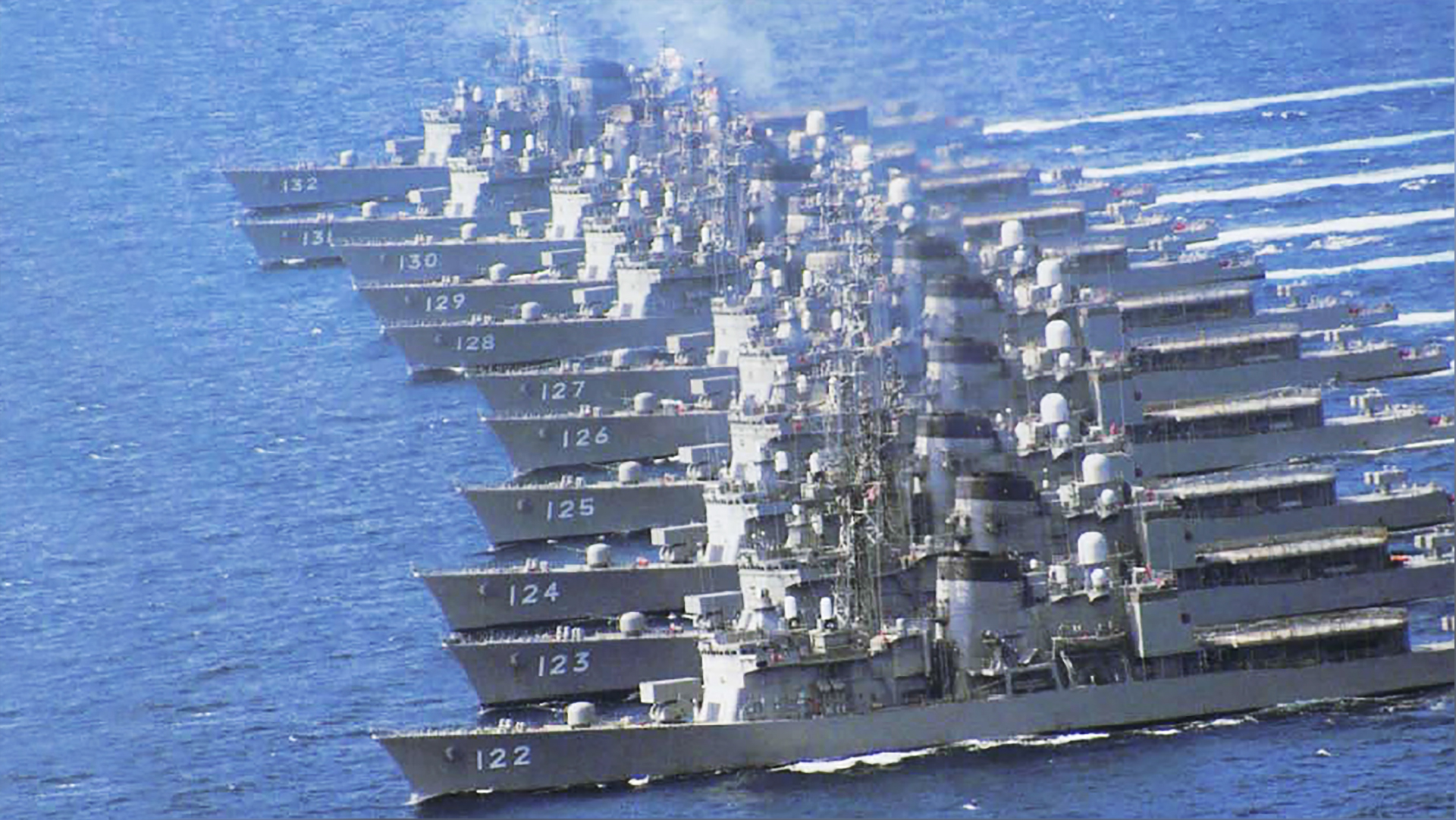A spectacle of a snapshot shared on Twitter by the official Japan Maritime Self-Defense Force (JMSDF) account shows 11 of the 12 Hatsuyuki-class destroyers ever produced sailing side-by-side in an imposing formation. The vessels are lined up in the order of their hull numbers, which are on clear display in the photo.
The fact that DD-122, the oldest vessel in the class, is included in the photo of the lineup means that it was likely taken prior to 2010 when the ship was decommissioned. This would suggest that the image was captured over a decade ago and, while we don’t have an exact date, the picture still serves as a visual reminder of the lauded destroyers’ time at sea.
The Hatsuyuki-class ships are surely deserving of a little memorializing, at least from a technical standpoint, considering that these vessels were the first generation of ‘general-purpose’ destroyers to ever serve the JMSDF.
Built under a collaboration between multiple manufacturers including Hitachi Zosen Corporation and Mitsubishi Heavy Industries, the Hatsuyuki-class frigates were the first type of vessel in Japanese service to be designated as general-purpose, or DD, which is a broadly used categorization for destroyers that combine both anti-aircraft and anti-submarine capabilities. Up until the introduction of the Hatsuyuki class, previous JMSDF destroyer classes had been designated as DDA for the anti-aircraft type and DDK for the anti-submarine type.
At its peak, 12 destroyers made up the Hatsuyuki-class fleet, with the ships having hull numbers beginning at DD-122 and ending with DD-133. The first ship in the class, the JS Hatsuuki (DD-122), was laid down in 1979, launched the following year, and finally commissioned in 1982. Production then quickly ramped up, and the remaining 11 vessels were all launched and commissioned by the end of the 1980s.

The ships are about 426 feet in length and have an average displacement of around 3,000 tons, with ships DD-129 through DD-133 clocking in on the heavier side after manufacturers began building the ships with steel as opposed to the aluminum alloy that was used for the initial seven. Hatsuyuki was also the first JMSDF destroyer class to use a combined gas propulsion system comprised of two Kawasaki-Rolls-Royce Tyne RM1C gas turbines for cruising and two much more powerful Kawasaki-Rolls-Royce Olympus TM3B gas turbines for achieving its max speed of 30 knots.
During the Cold War, Japan held reviews for both series of the JMSDF’s destroyer fleet and concluded that additional work needed to be done in order to keep pace with the technological advancements of adversarial nations in the 1970s. For example, the Soviet Union’s enhanced submarine fleet and anti-ship missiles prompted Japan to optimize its naval presence. The reviews thereby led the JMSDF to adopt what is described as the ‘eight ships, eight helicopters’ concept, which meant that each flotilla would be comprised of one helicopter destroyer, or DDH, two guided-missile destroyers, or DDGs, and five of the newly conceptualized general-purpose destroyers to better round out their maritime defense.

In terms of armaments, the Hatsuyuki class was the first of the JMSDF to be equipped with the Sea Sparrow missile system which used a Japanese-made FCS-2 fire control system and was located on the stern in a box launcher. In addition to the Sea Sparrow, the Hatsuyuki-class was armed with a 76 mm naval gun manufactured by OTO Melara, two 20 mm Phalanx Close-In Weapon System point-defense weapons made by General Dynamics, as well as the Boeing-made Harpoon anti-ship missiles. On top of that, eight RUR-5 anti-submarine rockets and their respective launcher are on board along with two HOS-301 triple torpedo tubes intended for Mk-46 torpedoes.
In 2010, however, budget constraints made it so that the JS Hatsuyuki became the first of its class to be decommissioned. From then until 2016, six other destroyers were also removed from service, and the remaining five followed suit between the years 2020 and 2021. Japan has dramatically upgraded its fleet of surface combatants over the last two decades, leaving the Hatsuyuki-class far outmatched in terms of capabilities.

That isn’t the end-all-be-all for the Hatsuyuki class, though, because between 1999 and 2016, four of these ships were repurposed to serve as training vessels. Despite the conversion, footage that has surfaced showing the training ships in action reveals that they still have their weapons systems intact.

Considering that all of the Hatsuyuki-class destroyers’ combat days have come and gone, and only a select few were spared for training, the photo may later serve as a record of the fleet’s final gathering, sans DD-133. Regardless, it was certainly a sight to behold.
Banner image has sea area expanded on the left side to fit banner proportions. Original is embedded in this article.
Contact the author: Emma@thewarzone.com
